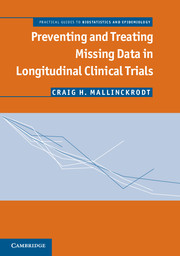Book contents
2 - Missing Data Mechanisms
Published online by Cambridge University Press: 05 February 2013
Summary
Introduction
One of the keys to understanding the potential impact of missing data is to understand the mechanism(s) that gave rise to the missingness. However, before considering missing data mechanisms, two important points are relevant. First, there is no single definition of a missing value. Even if restricting focus to dropout (withdrawal), several possibilities exist. For example, values may be missing as the result of a patient being lost to follow-up, with nothing known about treatment or measurements past the point of dropout. Alternatively, a patient may withdraw from the initially randomized study medication and be given an alternative (rescue) treatment, but with no further measurements taken. Or, follow-up measurements may continue after initiation of the rescue treatment. All these and other scenarios may happen within a single trial, with differing implications for appropriate handling of the data (Mallinckrodt and Kenward, 2009).
Moreover, the consequences of missing values are situation dependent. For example, in a clinical trial for diabetes, if a patient is lost to follow-up halfway through the trial, information needed to understand how well the drug worked for that patient is indeed missing. On the other hand, in a trial for a treatment to prevent breast cancer, if a patient dies from breast cancer midway through the trial, follow-up data are again incomplete; however, information about how well the treatment worked for that patient is not missing because it is known that the treatment did not work.
- Type
- Chapter
- Information
- Preventing and Treating Missing Data in Longitudinal Clinical TrialsA Practical Guide, pp. 9 - 14Publisher: Cambridge University PressPrint publication year: 2013

